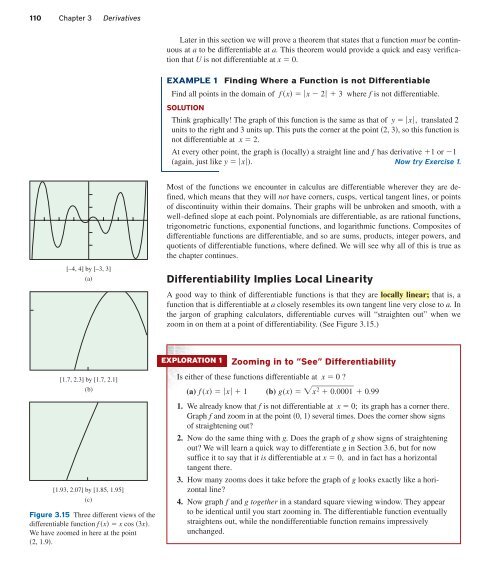5128_Ch03_pp098-184
Create successful ePaper yourself
Turn your PDF publications into a flip-book with our unique Google optimized e-Paper software.
110 Chapter 3 Derivatives<br />
Later in this section we will prove a theorem that states that a function must be continuous<br />
at a to be differentiable at a. This theorem would provide a quick and easy verification<br />
that U is not differentiable at x 0.<br />
EXAMPLE 1 Finding Where a Function is not Differentiable<br />
Find all points in the domain of f x x 2 3 where f is not differentiable.<br />
SOLUTION<br />
Think graphically! The graph of this function is the same as that of y x, translated 2<br />
units to the right and 3 units up. This puts the corner at the point 2, 3, so this function is<br />
not differentiable at x 2.<br />
At every other point, the graph is (locally) a straight line and f has derivative 1 or 1<br />
(again, just like y x). Now try Exercise 1.<br />
Most of the functions we encounter in calculus are differentiable wherever they are defined,<br />
which means that they will not have corners, cusps, vertical tangent lines, or points<br />
of discontinuity within their domains. Their graphs will be unbroken and smooth, with a<br />
well-defined slope at each point. Polynomials are differentiable, as are rational functions,<br />
trigonometric functions, exponential functions, and logarithmic functions. Composites of<br />
differentiable functions are differentiable, and so are sums, products, integer powers, and<br />
quotients of differentiable functions, where defined. We will see why all of this is true as<br />
the chapter continues.<br />
[–4, 4] by [–3, 3]<br />
(a)<br />
Differentiability Implies Local Linearity<br />
A good way to think of differentiable functions is that they are locally linear; that is, a<br />
function that is differentiable at a closely resembles its own tangent line very close to a. In<br />
the jargon of graphing calculators, differentiable curves will “straighten out” when we<br />
zoom in on them at a point of differentiability. (See Figure 3.15.)<br />
EXPLORATION 1<br />
Zooming in to “See” Differentiability<br />
[1.7, 2.3] by [1.7, 2.1]<br />
(b)<br />
[1.93, 2.07] by [1.85, 1.95]<br />
(c)<br />
Figure 3.15 Three different views of the<br />
differentiable function f x x cos 3x.<br />
We have zoomed in here at the point<br />
2, 1.9.<br />
Is either of these functions differentiable at x 0 ?<br />
(a) f (x x 1 (b) g(x x 2 0.0001 0.99<br />
1. We already know that f is not differentiable at x 0; its graph has a corner there.<br />
Graph f and zoom in at the point 0, 1 several times. Does the corner show signs<br />
of straightening out?<br />
2. Now do the same thing with g. Does the graph of g show signs of straightening<br />
out? We will learn a quick way to differentiate g in Section 3.6, but for now<br />
suffice it to say that it is differentiable at x 0, and in fact has a horizontal<br />
tangent there.<br />
3. How many zooms does it take before the graph of g looks exactly like a horizontal<br />
line?<br />
4. Now graph f and g together in a standard square viewing window. They appear<br />
to be identical until you start zooming in. The differentiable function eventually<br />
straightens out, while the nondifferentiable function remains impressively<br />
unchanged.












